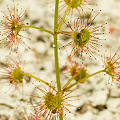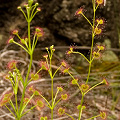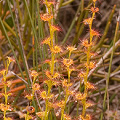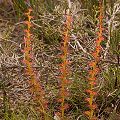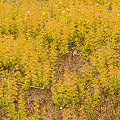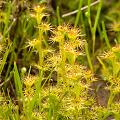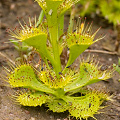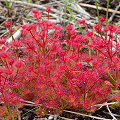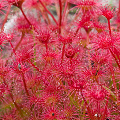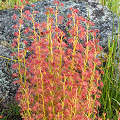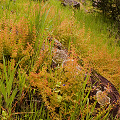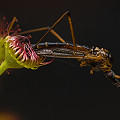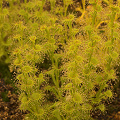| The Tuberous Fan-leaved Drosera1 | |
|---|---|
|
D. fimbriata D. humilis2 D. monticola2 D. platypoda D. porrecta2 |
D. prostrata2 D. purpurascens2,3 D. ramellosa D. rupicola2 D. stolonifera |
|
1All in Drosera section Stolonifera 2Formerly considered a subspecies of D. stolonifera. 3Formerly called D. stolonifera subsp. compacta. |
|
Q: The tuberous fan-leaved Drosera
A: Plants in section
Stolonifera have, for the most part, erect stems
and leaves that are somewhat fan-like. I editorialize freely when I note that these include some of my all-time favorite
Drosera, especially the ab-fab D. platypoda!
Some of these species are exceptionally easy to grow, in particular D. ramellosa and
D. stolonifera. The former is quite kind in producing viable seed, even when selfed. Both these species
are also very generous in producing extra tubers every year, so that a single plant will, in time, fill a pot with marvelous
plants.
Why do I like these plants so much? There is something to the tiered structure to the leaves, especially in the ascending species
like D. stolonifera and D. platypoda, that is really marvelous.
Drosera fimbriata
This species is atypical of the group in that it does not form a basal rosette. Instead, the stem base is ringed by sets of
radiating hairs.
Drosera platypoda
Upward-facing leaves, often extremely brightly colored, seduce my aesthetics! The stem does not branch, and each plant looks
like a strange, extending octopus arm reaching from the ground. Quite nice.
The stem of this plant is strangely fleshy, and not wiry like the erect or scrambling tuberous Drosera,
yet it does not topple even in fairly high winds.
Drosera porrecta
This species is more delicate, and has small leaves on long petioles. At first glance, it looks just like
a normal erect tuberous sundew. But if you look closely, you notice the leaves are fan-shaped.
Drosera purpurascens
The clumpy species used to be considered a subspecies of Drosera stolonifera, but it is much more
compact. (Indeed it was called subsp. compacta!) Plants I have seen in the wild can be
very deep red.
Drosera ramellosa
This pale green plant can occur in very dense populations, excluding nearly all other plants.
In cultivation, this character exhibits itself
by the plant's proliferative nature. All the photographs I have seen suggest it is uniform in
appearance over its entire range. This is interesting, because its range is very large in Western Australia and seems to
be broken into separate chunks.
Drosera stolonifera
A rank grower that gets a little floppy in cultivation (and in the wild). Because of this character I don't like it quite as
much as the others in cultivation. However, when it emerges from dormancy, the bud tip is encased in a ball of mucus, which admittedly
raises its cachet in my book.
Plants in cultivation tend to be uniformly green, in my experience. Meanwhile, plants in the wild range from green to
orange and red. I cover the basics of cultivation on my page describing tuberous rosetted Drosera.
Page citations: Lowrie, A. 1987, 1989, 1999, 2005; 2013; Lowrie, A. et al. 2017a, 2017b; Rice, B.A. 2006a; Robinson, A. et al. 2017;Schlauer, J. 1996, 2002; Taton, A. 1945.
